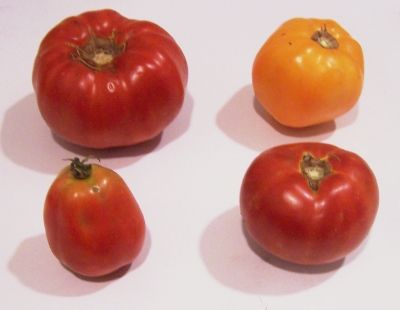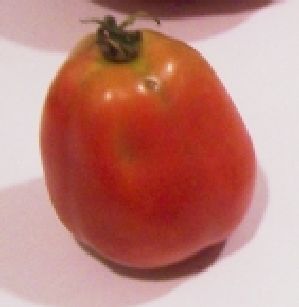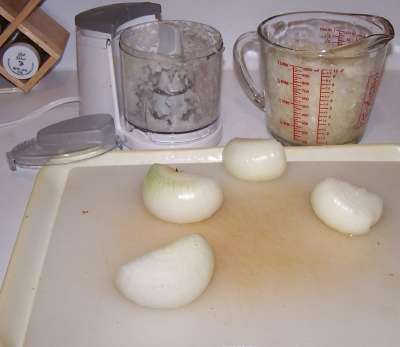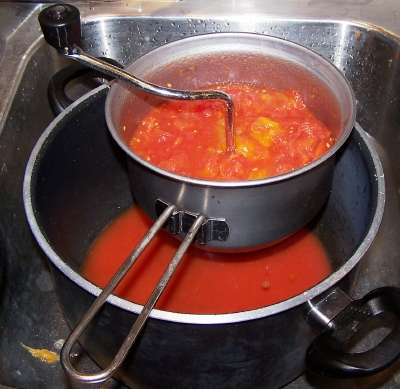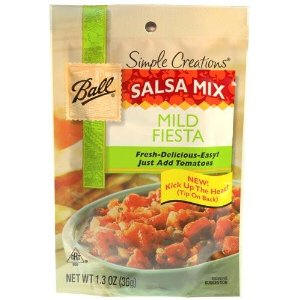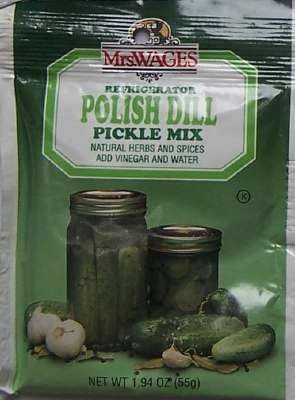How to Make Spicy Ketchup (or Catsup) - Easily! With Step-by-step Photos, Recipe, Directions, Ingredients and Costs
This month's notes: April 2024: Stored US apples are still available. See your state's crop availability calendar for more specific dates of upcoming crops.
Valentine's Day - February 14 - See this website for Valentines Day history, facts and top picks for fast, easy, inexpensive gifts for the man, woman or children in your life!
Easter will be April 16, 2017 - if you want to take your children to a free Easter egg hunt - see our companion website to find a local Easter Egg hunt!
And we have home canning, preserving, drying and freezing directions. You can access recipes and other resources from the drop down menus at the top of the page or the site search. If you have any questions or suggestions, feel free to write me! Also make your own ice cream; see How to make ice cream and ice cream making equipment and manuals. Have fun, eat healthier and better tasting, and save money by picking your own locally grown fruit and vegetables, and then using our easy directions
 Subscribe
to our: Email
alerts; Follow us on Twitter
Add
this page to your favorites! -
Email this page to a friend, or to yourself
Subscribe
to our: Email
alerts; Follow us on Twitter
Add
this page to your favorites! -
Email this page to a friend, or to yourself
Making and Canning Homemade Spicy Catsup from Fresh Tomatoes!
We take catsup for granted - it is everywhere and Americans use it in almost everything. Some even put it on scrambled eggs. So maybe you wondered if homemade catsup taste any different or better? And if you have a mountain of homegrown tomatoes that are going to waste, here's your chance to make your own catsup and customize to your own taste! Need a low-salt diet? Skip the salt! Want a spicy catsup? Add some Tabasco or chilies. Making and canning your own catsup is something families remember years later. No store bought catsup compares with the taste of that made from your own tomatoes from your garden or fresh-picked from a local farm! In the middle of the winter, you can pour the catsup on your food and taste the summer flavor of fresh tomatoes.
Here's how to do it, in easy steps and completely illustrated. This method is easy, ANYONE can do this; but it IS time consuming - I will warn you of that! And it is more complicated than spaghetti sauce, so I'd recommend trying that first. Using a crockpot to cook the tomatoes down really helps save time, though!! It's a great thing to do with your kids!
Ingredients and Equipment
|
|
Process - How to Make Spicy Catsup from Fresh Tomatoes
Step 1 - Selecting the tomatoesIt's fun to go pick your own and you can obviously get better quality tomatoes! At right is a picture of tomatoes from my garden - they are so much better than anything from the grocery store. And if you don't have enough, a pick-your-own farm is the pace to go! At right are 4 common varieties that will work:
|
|
||||||||||
|
|
The picture at left shows the best variety of tomato to use: Roma; also called paste tomatoes. they have fewer sides, thicker, meatier walls, and less water. Also, you don't want mushy, bruised or rotten tomatoes! |
||||||||||
Step 2 - Removing the tomato skinsHere's a trick you may not know: put the tomatoes, a few at a time in a large pot of boiling water for no more than 1 minute (30 - 45 seconds is usually enough) then.... |
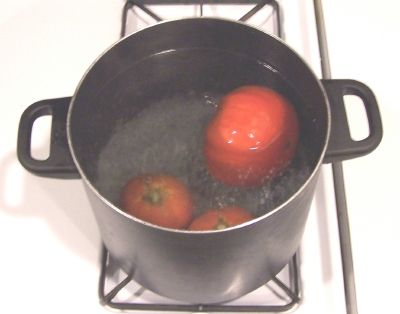 |
||||||||||
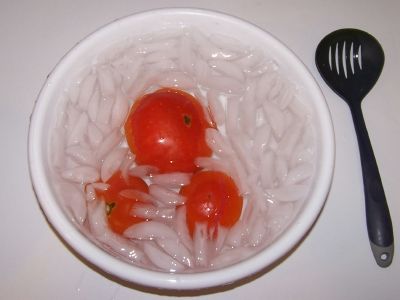 |
Plunge them into a waiting bowl of ice water.
This makes the skins slide right off of the tomatoes! If you leave the skins in, they become tough and chewy in the sauce, not very pleasant. |
||||||||||
Step 3 - Removing seeds and waterAfter you have peeled the skins off the tomatoes, cut the tomatoes in half. Now we need to remove the seeds and excess water. |
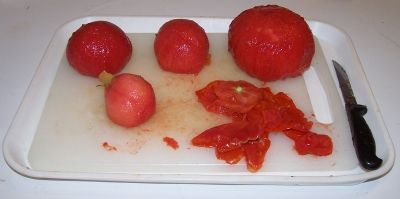 |
||||||||||

|
Step 4 - Squeeze of the seeds and waterJust like it sounds: wash your hands then squeeze each tomato and use your finger or a spoon to scoop and shake out most of the seeds. You don't need to get fanatical about it; removing just most will do. Another way to do it is to cut each tomato in half, across it, instead of lengthwise. Then just shake the seeds and juice out.
|
||||||||||
Step 5 - Drain the tomatoesToss the squeezed (Squozen? :) tomatoes into a colander or drainer, while you work on others. This helps more of the water to drain off. You may want to save the liquid: if you then pass it through a sieve, screen or cheesecloth, you have fresh tomato juice; great to drink cold or use in cooking! |
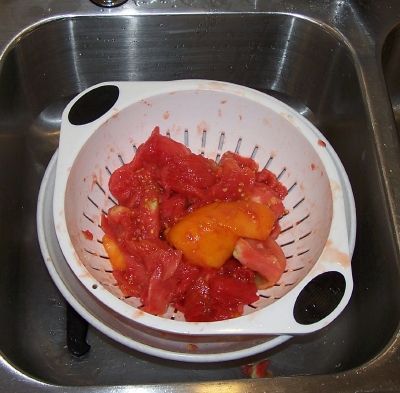 |
||||||||||
 |
Step 6 - Get the jars and lids sanitizingThe dishwasher is fine for the jars; especially if it has a "sanitize" cycle. I get that going while I'm preparing everything else, so it's done by the time I'm ready to fill the jars. Be sure to let it go through the rinse cycle to get rid of any soap! It's also a good time to start heating up the water in the canner and the small pan of water to warm the lids to soften the adhesive.
|
||||||||||
|
Lids: Put the very hot (but not quite boiling; around 180 F, steaming water is fine) Note: everything gets sanitized in the water bath (step 7) anyway, so this just helps to ensure there is no spoilage later!)
|
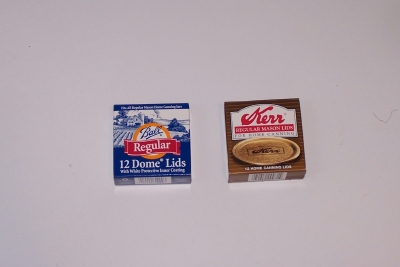 |
||||||||||
Step 7. SeasoningsSome of the seasonings will straight into the pot with the tomatoes, the rest will go into a spice bag you make from a piece of cheesecloth. Put the tomatoes in a large pot to start simmering. Into the pot of simmering tomatoes, put:
|
|
||||||||||
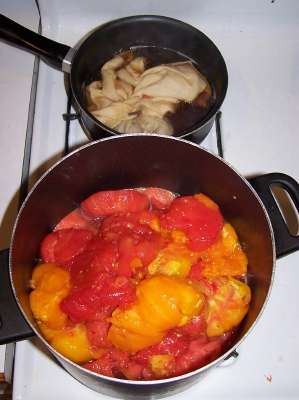 |
Onto a piece of cheesecloth (about 12 inches square) put:
Tie the corners of the cloth together to make a little bag (you can use a plastic twist tie - I use one from a oven browning bag) and put the bag into a small sauce pot with
Let it simmer for 30 minutes, while the tomatoes cook (you may need to add more vinegar, so you finish with 3 cups of liquid)
|
||||||||||
Step 8 - Bring the tomatoes to a gentle simmerCook the tomatoes for about 20 - 30 minutes over medium heat to make them mushy enough to go through your food mill or sieve.
|
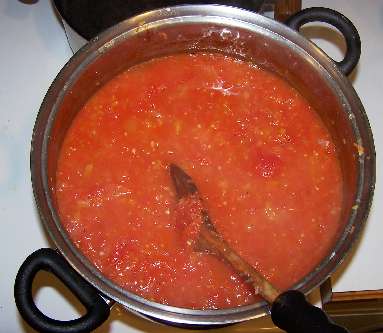 |
||||||||||
|
|
Step 9 - Removing the seeds and skinsRun the cook tomato mixture through the food mill or sieve. Discard the seeds and skins that remain in the sieve..
|
||||||||||
Step 10 - Add the seasoned vinegar and cook down to thicken the mixNow it's time to add the seasoned vinegar from step (minus the cheesecloth bag, which you may now discard), and cook down the mixture to thicken it. You can do it on the stove over low - medium heat, stirring frequently, as shown at right.. OR.... |
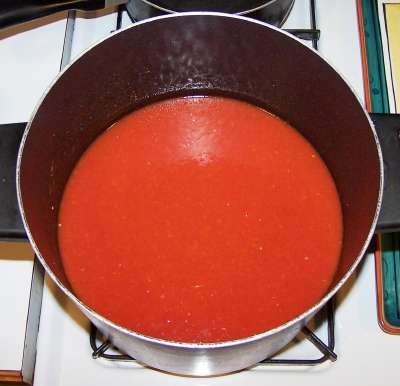 |
||||||||||
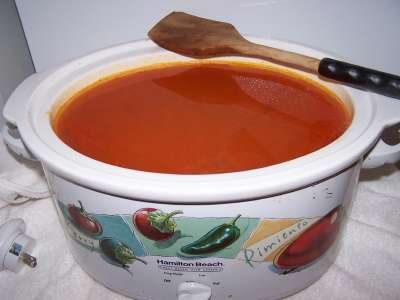 |
.. put it into a crockpot and let it cook down by itself. this method is much easier! I find it takes about 12 hours, but each crockpot may vary. You want it to get as thick as you like your catsup, remembering that it will also thicken a little bit after you cool it. | ||||||||||
Step 11 - Fill the jars with the catsup and put the lid and rings onFill them to within 1/4-inch of the top, seat the lid and hand-tighten the ring around them. |
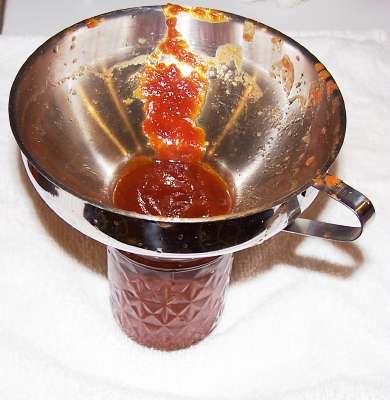 |
||||||||||
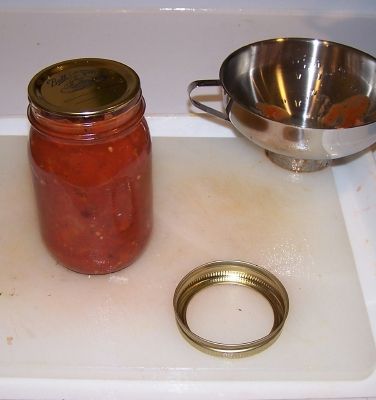 |
Be sure the contact surfaces (top of the jar and underside of the ring) are clean to get a good seal! | ||||||||||
Step 12 - Process (boil) the jars in the cannerPut them in the canner and keep them covered with at least 1 inch of water. Keep the water boiling. Process the jars in a boiling-water bath for 35 minutes for pints and 40 minutes for quarts. Remember to adjust the time if you are at a different altitude other than sea level!
|
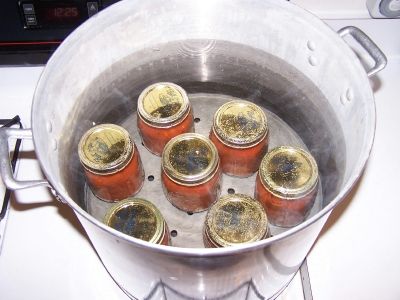 water bath canner (above) |
||||||||||
|
If you have a Pressure Canner, use it and process the sauce for 30
minutes for pint jars and 35 minutes for quarts, at a pressure of 10 to 11
pounds. I prefer a Pressure Canner or a larger 33 quarter water bath
canner, shown at right - both are much deeper, so there is no mess, no
boilovers, and allows you to cover the tallest jars with several inches of
water to ensure safety! To order one, click on
Canning supplies and select
the canner that is right for your stove (regular or flat bottomed for
glass or ceramic stoves) If you have a Pressure Canner, be sure to follow their directions. |
 <-pressure canner
<-pressure canner |
||||||||||
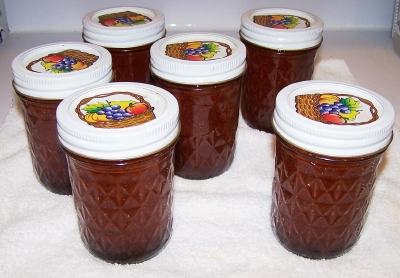 |
Step 13 - DoneLift the jars out of the water and let them cool without touching or bumping them in a draft-free place (usually takes overnight) You can then remove the rings if you like, but if you leave them on, at least loosen them quite a bit, so they don't rust in place due to trapped moisture. Once the jars are cool, you can check that they are sealed verifying that the lid has been sucked down. Just press in the center, gently, with your finger. If it pops up and down (often making a popping sound), it is not sealed. If you put the jar in the refrigerator right away, you can still use it. Some people replace the lid and reprocess the jar, then that's a bit iffy. If you heat the contents back up, re-jar them (with a new lid) and the full time in the canner, it's usually ok.
|
||||||||||
|
|
|||||||||||
Other Equipment:From left to right:
|
 |
||||||||||
Summary - Cost of Making Homemade Catsup - makes 7 - 8 oz jars* |
||||
| Item | Quantity | Cost in 2024 | Source | Subtotal |
| Tomatoes | 25 lbs (to make about 16 cups of prepared tomato) | free from the garden, or $0.50 cents at a PYO | Garden | $0.00 |
| Canning jars (8 oz size, wide mouth), includes lids and rings | 7 jars | $6.50/dozen | Grocery stores, like Publix, Kroger and Safeway and local "big box" stores; sometimes Big Lots and even hardware stores | $3.50 |
| seasoning | See step 7 | $1.00? assuming you already have them. just the fraction you will use. | Grocery stores, like Publix, Kroger and Safeway and local "big box" stores | $1.00 |
| Total | $4.50 total or about $0.65 per jar INCLUDING the jars - which you can reuse! |
|||
|
* - This assumes you already have the pots, pans, ladles,, and reusable equipment. Note that you can reuse the jars! |
||||
| See here for related tools, equipment, supplies on Amazon See here for related tools, equipment, supplies on Amazon See here for related tools, equipment, supplies on Amazon 
|
Home Canning KitsThis is the same type of standard canner that my grandmother used to
make everything from applesauce to jams and jellies to tomato and
spaghetti sauce. This complete kit includes everything you need and lasts
for years: the canner, jar rack, Jar grabber tongs, lid lifting wand, a
plastic funnel, labels, bubble freer, and the bible of canning, the Ball
Blue Book. It's much cheaper than buying the items separately. You will never need anything else except jars & lids (and the jars are reusable)!
There is also a simple kit with just the canner and rack, and a Pressure Canner, if you want to do vegetables (other than tomatoes). To see more canners, of different styles, makes and prices, click here! |
Lids, Rings, Jars, mixes, pectin, etc.Need lids, rings and replacement jars? Or pectin to make jam, spaghetti sauce or salsa mix or pickle mixes? Get them all here, and usually at lower prices than your local store! |
Answers to Common Questions
What did I do wrong if my jars spoil?
Tomatoes are a borderline acid / low acid fruit (see this page about tomato acidity for more information) - adding lemon juice helps, processing at least 35 minutes in the water bath canner, or better still, using a Pressure Canner almost eliminates spoilage. If you don't have a pressure canner, you must boost the acid level of the sauce, by adding 2 tablespoons of lemon juice or 1/2 teaspoon of citric acid per quart of sauce.
Illustrated Canning, Freezing, Jam Instructions and Recipes
[ Easy Home Canning Directions] [FAQs - Answers to common questions and problems] [Recommended books about home canning, jam making, drying and preserving!] [Free canning publications to download and print]


